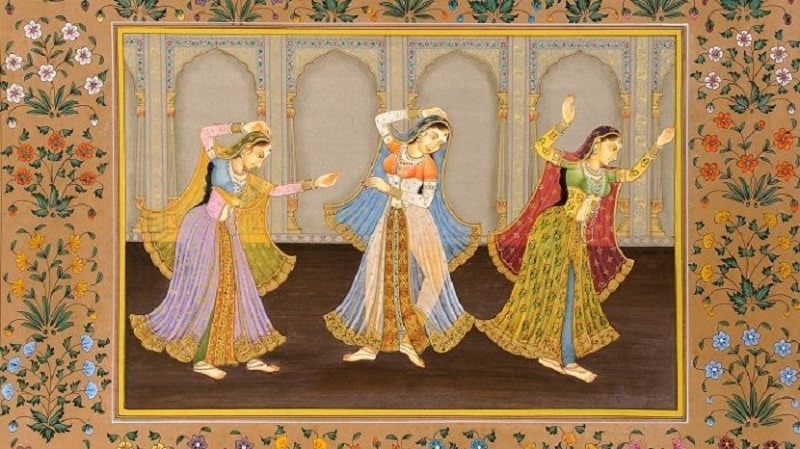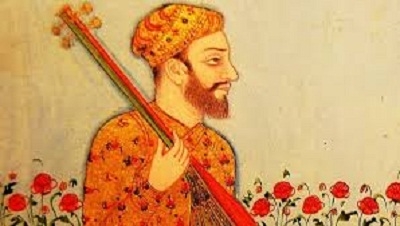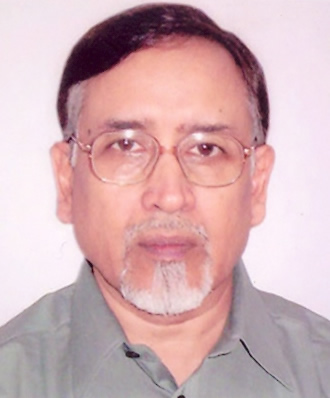Cultural apartheid cuts Mughal Royal's love for Indian Culture

Since the time of independence in 1947, the Muslims of Uttar Pradesh have shown a welcome sign of cultural integration; they have learned Hindi and have started to read the same newspapers, magazines and books as their next-door Hindu neighbors.
This is not the first time in history that such a thing is happening. Our early Muslim conquerors, who settled in and around Delhi, had shown a similar mindset. Their official language for administration was Persian, but they had to deal with the Hindi-speaking subjects, who had no knowledge of Persian, and their own tongue was either medieval Pashtun or Turkish.
This quadri-lingual confusion could not carry on for long. The Muslim rulers very quickly made medieval Hindi a language of their own. The administrative records were maintained in Persian, but the lingua franca, that is, the language of common communication and grass root administration became the medieval Hindi.
Medieval dialects of Hindi descended from Apabhramsa that predates even the early Muslim invaders, like Mahmud Gazanvi (Shukla 1940, Dinkar 1956, Khan 1987). Dinkar’s magnum opus, ‘Sanskritike Char Adhyaya’, is a work of immense scholarship, with a foreword written by Pandit Jawaharlal Nehru that received the Sahitya Academy Award. I need to refer to these works repeatedly, and hereafter, I shall give only page numbers of these works, while referring to them.
Right from late ancient and early medieval days, both Hindus and Muslims had been writing poetry in various dialects of North India ̶ Khadi Boli, Braja and Awadhi. These dialects are often called proto-Hindi or medieval Hindi. They were close to each other; for instance, a speaker of Kahdi Boli could easily understand Braja or Awadhi. All three were written in Nagari script.
 Abdulla Iraqi translated the Quran into Hindi in 892 CE (Dinkar p. 390). The earliest written specimens of Khadi Boli poetry are found in the writings of Amir Khusrau (1253 – 1325 CE). Although well-versed in Persian, he wrote extensively also in Braja (Shukla pp. 2, 34, 36, 111, 284; Dinkar pp. 380-381). An example of Sufi spiritual poetry composed by Khusrau is given here.
Abdulla Iraqi translated the Quran into Hindi in 892 CE (Dinkar p. 390). The earliest written specimens of Khadi Boli poetry are found in the writings of Amir Khusrau (1253 – 1325 CE). Although well-versed in Persian, he wrote extensively also in Braja (Shukla pp. 2, 34, 36, 111, 284; Dinkar pp. 380-381). An example of Sufi spiritual poetry composed by Khusrau is given here.
खुसरो रैन सुहाग की, जागी पी के संग। तन मेरो मन पीउ को, दोउ भये एक रंग॥
(Khusrau spends the night of union wakeful with the beloved/ The body belongs to me but the mind to my beloved, the two merging in a monochrome.)
The earliest writing of Braja prose has been dated to mid-fourteenth century and the earliest example of Khadi Boli prose dated to Moghul King Akbar’s reign, by these authors. Certain coins of Mahmud Gazanvi, Mohammad Ghori and Sher Shah Suri carry Nagari inscriptions; and many specimens are preserved in various museums of India and Pakistan. Akbar issued many interesting coins. One of his most important coins displays Rama, the hero of Hindi epic Ramayana and his wife Sita on obverse, while a word Ramaraj in Nagari script is on reverse.
Use of Hindi in the administration during the medieval era was not a mere political expediency, the rulers started to love Hindi. Akbar composed a couplet when his friend Raja Birbal died. Birbal used to give away all his year’s earnings to the poor on every birthday. Hence, a grieving Akbar wrote:
दीन जानि सब दीन, एक न दीन्हों दुसह दुख। सो मो कहें अब दीन, कछु कन राख्यौ बीरबल॥
(The poor knew (him) well, he never hurt anyone/ The poor tell me that Birbal did not keep anything (wealth) for himself.)
Some Mughal princes had two names, one Arabic and another Hindi. Shah Jahan gave Aurangzeb an alternative Hindi name, Navarang Bihaari. This name appears in the works of contemporaries of Aurangzeb, like Bhushan, the court poet of Shivaji (Dinkar p. 627). Unable to bear imprisonment in the hands of Aurangzeb, Shah Jahan lamented in a verse.
जन्मत ही लाख दान दियो, अरु नाम रख्यौ नवरंगबिहारी,
बाल हीं सों प्रतिपाल कियो, देस मुलुक्क दियो दलभारी।
सो सुत वैर बुझै मन में, धरि हाथ दियो बैंधसार में डारी,
शाहजहां विनवै हरि सों बलि, राजीवनैन रजाय तिहारी॥
(When he was born, I gave lakhs of gifts and named him Navarang Bihaari; brought him up with care and made him satrap of a territory with a large army. This son nurtured enmity in mind and put my hands in chains, Shahjahan submits to God saying, “Oh Almighty! All that happens is your will”.)
The use of the Persian word मुलुक्क is notable. More notable is the usage of Sanskrit words हरि and राजीवनैन for God (Allah), although the latter, meaning lotus-eyed, is an epithet for Vishnu in Hindu scriptures. The vocabulary of this language included all words that were in popular usage. No word, Persian or Sanskrit, were deliberately kept out. In other words, this language was an inclusive language, a language of integration.
Famous linguist Dr.Suniti Kumar Chatterji has written that according to “Mayasire-Alamgiri”, while Aurnagzeb was in the Deccan (a region south of the Narmada River) in 1690, a Muslim from Bengal met him and wished to be his disciple; Aurangzeb, for some reason, was displeased with him, and quoted a popular couplet of the region to deride him (Dinkar, p. 391):
टोपी लेंदे, बावरी देंदे, खरे निलज । चूहा खांदा बावली, तू कल बंधे छज्ज ।।
(You want to give up long hair and wear the cap (of a Fakir), Oh shameless man! Your house is being eaten by rats and you talk of erecting a new roof.)
Aurangzeb’s daughter, Zibunnisa, authored a book named Naina Vilaasa. When his son Mohammad Azam Shah sent certain varieties of mangoes and asked him to name them, Aurangzeb coined two names Sudhaarasa and Rasna Vilaasa (Dinkar p. 391).
It is clear that the Moghul royals, within a generation of coming into India, became comfortable speakers of medieval Hindi. They made the language their own and wrote poetry in it. It was not only that a linguistic integration was in progress, there was also a syncretic give-and-take between the two religions, Hinduism and Islam.
Akbar arranged translation of the Sanskrit texts of Ramayana, the Artharva Veda and the Leelavati (a treatise in Mathematics) into Persian. The Hindu epic Mahabharata was translated into a Persian book called Razmnama (Book of Wars).The head of the translation project was Akbar’s court historian, Abu al-Fazl.
He converted the raw translation into poetic verses. His other contribution was translation of the Bible into Persian. Shah Jahan’s eldest son Dara Shikoh translated the Sanskrit Upanishads into Persian Upanikhats. He also wrote a book called Majma Ul Bahrain (Meeting of the two oceans), wherein the two oceans are Hinduism and Islam. The story of Dara Shikoh’s assassination and Aurangzeb’s ascension on the throne is too well known to be retold here.
Arrival of Urdu
Aurangzeb’s rule was a turning point in history. He gave a sectarian and illiberal turn to politics by imposing the Jizia tax on Hindus. Coincidentally, there was a sectarian turn in linguistics that happened in his times, but for which he was not responsible. Aurangzeb spent a good part of his life in military campaigns in the Deccan, where he set up an alternative administrative and operational centre in Aurangabad. It is here that poet Wali Dakhni arrived with his poetry, written in a new language called Urdu.
It is necessary here to say a few words about the origin and growth of Urdu. Three centuries ago, one of Delhi’s Pathan rulers, Mohammad Bin Tughlaq had shifted his capital from Delhi to Daulatabad in the Deccan, albeit temporarily. This had resulted in a substantial shift of population from the Delhi region to the Deccan and brought Khadi Boli there.
Dinkar, Suniti Kumar Chatterji and R. S. McGregor, all great scholars of repute, hold that it was Khadi Boli of the North that started being written in the Arabic script and acquired many words from the local dialects of the Deccan, and at that moment Dakhni-Urdu was born (the word Dakhni means southern and is derived from Sanskrit Dakshin). Muslim rulers of the Deccan adopted the language and patronized its literature. Dinkar notes that the poets of Dakhni-Urdu used Persian meters.
The earliest work of poetry in Dakhni-Urdu has been attributed to the first king of the Adil Shahi dynasty, Ibrahim Adil Shah (1571 – 1626 CE). He was followed by later rulers. Ibrahim Adil Shah studied the Sanskrit Natya Shastra, a treatise in dramatics, which professes nine rasas or moods and wrote Nauras-nama in Urdu. As is the custom in Sanskrit literature, he invoked the following invocation to Goddess Saraswati and God Ganesh:
Saarada Ganesh maataa pitaa/Tum mano nirmal beeb sphatik.
It was actually written in Arabic script; but for the convenience of the reader, we give a version in Nagari script also:
सारदा गणेश माता पिता। तुम मनो निर्मल बीब स्फटिक।।
(Saraswati and Ganesh are (like) mother (and) father/ You are like transparent crystals.)
Here the title Nauras-nama is a mixture of Sanskrit and Persian and the poetry is rich in Sanskrit words. In its vocabulary and theme, it is integrationist and syncretic with Indian culture, much like the poetry of Akbar and Shah Jahan. But there are two major differences ̶ the script is Arabic and the meter is Persian. This combination of script and meter proved to be the thin end of the wedge that was to split asunder the culture of north India into two distinct compartments, in course of time.
This tradition of Dakhni-Urdu poetry grew to maturity over the centuries and finally arrived at Aurangzeb’s court in Aurangabad in the person of poet Wali Dakhni. In the meantime, the orthodox elements in the Mughal court were ascendant and became powerful at Aurangzeb’s time. They looked down upon the Indian vernacular as the language of the infidel. They took interest in Wali Dakhni’s works because they saw in it the successful adaptation of a local language that would lend itself to Persianization and can be a vehicle of orthodox thoughts (Dinkar p. 386).
Shah Gulshan, an elderly and respectable poet of Persian, advised Wali to use Persian words and exclude Sanskrit/vernacular words as far as possible. Wali took the advice and started to write a language that had pronouns and verbs that were Sanskritic, but all else (nouns, adjectives, adverbs etc) were Persian. The idioms and metaphors of Indian origin were sought to be expelled as far as possible. Dinkar called this Matrukaat ya Bahishkaar ki Niti, i.e., a policy of expulsion.
It should be noted that the Persian of the Mughal era had already been quite Arabized in the prior six centuries of its post-Islamic phase. Therefore, Persianization meant Persio-Arabization. Through this process, emerged the northern Urdu from the womb of Dakhni-Urdu, as a language of the Muslims, distinct from Hindi which was categorized as the language of the Hindus. Since then, for centuries the Hindus and Muslims have been reading different newspapers, magazines and books. They acquired different world-views or paradigms. This phenomenon can be labeled as ‘Voluntary Cultural Apartheid’ practiced by the Muslims.
Persianization and Arabization of Urdu has continued since then till today. Result: Though Urdu is the language of Uttar Pradesh, the present author, who lived in Uttar Pradesh for the greater part of his life and speaks fluently the local language, cannot follow the Urdu news bulletins issued by Lucknow Doordarshan.
The irony is that even a common Muslim, who hasn’t had any education beyond the primary or who is often illiterate, cannot understand much from this news broadcast; whereas a common Hindu with the same level of education can comprehend a fair bit from the Hindi news bulletin, because it is not filled with foreign and unfamiliar words.
The Urdu stalwarts are still travelling down the same road and now they are debating if the Persian word Namaaz should be replaced by the Arabic Ibaadat. But the common people are not toeing their line, as more and more Muslim families are sending their children to Hindi medium schools. Thus, voluntary cultural apartheid is gradually weakening and being replaced by voluntary integration,
Conclusion
The Mughal Royals, contrary to popular misconception, spoke and wrote in medieval Hindi. The Mumbai film industry has popularized a myth that Akbar, Jahangir alias Salim, and their courtiers spoke in chaste Urdu, and this myth needs to be dispelled. The fact is that Urdu came to North much later; it arrived in Aurangzeb’s court during his declining years, and even he was not a speaker of Urdu. All words, idioms and metaphors of Indian origin (except the pronouns, verbs and syntax) were expelled from Urdu in its post-Aurangzeb phase, and the process continues till date uninterrupted. This led to linguistic separatism and eventually to cultural separatism, and the process is called Voluntary Cultural Apartheid.
Fortunately, we are seeing a gradual reversal of this process among the Muslims of north India. In this context, Shah Jahan’s poem quoted above acquires importance. It is a document, verily loaded with history, that shows that the Moghuls spoke and wrote poetry in medieval Hindi; that they had a custom of giving an alternative Hindi/Indian name to their sons; that they freely used Indian names, such as Hari (हरि), for God/Allah; and that Shah Jahan was shackled and imprisoned by his son Aurangzeb.
Besides all this, the poem is an example of good evocative lyric, full of pathos that touches the heart. To encourage the present trend of linguistic integration among the Muslims, this poem of Shah Jahan should be included in school text books for Hindi, alongside Saint Kabir’s couplets (in Awadhi dialect) which have already found a place in many such texts.
References
Dinkar, Ramdhari Singh (1956), Sanskritike Char Adhyaya(with a foreword by Pandit Jawahar Lal Nehru), Lok Bharati Prakashan, (Allahabad 2002).
Khan, Iqbal (1987), Rise of Urdu and Partition, Viewpoint, July-September, Lahore, Pakistan (Re-printed in The Times of India, October 2, 3 & 5, 1987, as one of the series to mark 40 years of Independence.)
Shukla, Ram Chandra (1940), Hindi Sahitya keItihas, Lok Bharati Prakashan, (Allahabad 2002).
